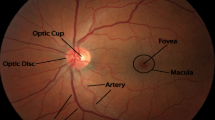Abstract
Glaucoma is an irreversible progressive vision condition that can lead to permanent sightlessness. With null early-stage symptoms, it is critical to prevent in advanced stages of glaucoma. Artificial intelligence has shown significant escalation, in many fields, especially in medical image diagnosis, wherein highly accurate automated disease diagnosis of a large dataset in less time has now become feasible. Researchers have utilized many machine learning and deep learning approaches for glaucoma detection from retinal fundus images, but their performance varies and it depends on the input dataset. According to the “No Free Lunch theorem”, a single classifier is not suitable for classifying all datasets. So, to overcome this situation, we have proposed an ensemble learning approach that utilizes different machine learning approaches for Glaucoma detection. A benefit of using ensemble learning is to improve the average prediction performance by combining predictions from multiple models. In this paper, we developed a machine learning model ensemble approach [Majority-Voting-Ensemble (MVE)] consisting of a Support Vector Machine (SVM), Random Forest (RF), Multilayer Perceptron (MLP) classifiers. Our approach involves the Histogram of Oriented Gradients (HOG) technique to collect efficient features for glaucoma detection. The efficiency of our proposed approach is evaluated using two popularly used benchmark datasets, called ORIGA and REFUGE. The results show that the proposed ensemble approach is capable of outperforming the base classifiers for glaucoma classification from fundus images.
Access this chapter
Tax calculation will be finalised at checkout
Purchases are for personal use only
Similar content being viewed by others
References
Lee DA, Higginbotham EJ (2005) Glaucoma and its treatment: a review. Am J Health-Syst Pharmacy 62(7):691–699. https://doi.org/10.1093/ajhp/62.7.691
Kingman S (2004) Glaucoma is second leading cause of blindness globally. Bull World Health Organ 82(11):887–888
Orlando JI et al (2020) Refuge challenge: a unified framework for evaluating automated methods for glaucoma assessment from fundus photographs. Med Image Anal 59:101570. https://www.sciencedirect.com/science/article/pii/S1361841519301100
Dey A, Bandyopadhyay S (2016) Automated glaucoma detection using support vector machine classification method. Br J Med Med Res 11:1–12
Balasubramanian T, Krishnan S, Mohanakrishnan M, Rao KR, Kumar CV, Nirmala K (2016) Hog feature based SVM classification of glaucomatous fundus image with extraction of blood vessels. In: 2016 IEEE annual India conference (INDICON), pp 1–4
Nirmala K, Venkateswaran N, Kumar CV (2017) Hog based naive Bayes classifier for glaucoma detection. In: TENCON 2017—2017 IEEE region 10 conference, pp 2331–2336
Kim SJ, Cho KJ, Oh S (2017) Development of machine learning models for diagnosis of glaucoma. PLOS ONE 12(5):1–16. https://doi.org/10.1371/journal.pone.0177726
Parashar DR, Agarwal DK (2021) SVM based supervised machine learning framework for glaucoma classification using retinal fundus images. In: 2021 10th IEEE international conference on communication systems and network technologies (CSNT), pp 660–663
Oh S, Park Y, Cho KJ, Kim SJ (2021) Explainable machine learning model for glaucoma diagnosis and its interpretation. Diagnostics 11(3). https://www.mdpi.com/2075-4418/11/3/510
Ravishyam D, Samiappan D (2021) Comparative study of machine learning with novel feature extraction and transfer learning to perform detection of glaucoma in fundus retinal images. In: Sharma TK, Ahn CW, Verma OP, Panigrahi BK (eds) Soft computing: theories and applications. Springer, Singapore, pp 419–429
Varshney H, Kant U, Gupta H, Verma OP, Sharma TK, Ansari IA (2021) Semantic segmentation of retinal blood vessel with autoencoders. Soft computing: theories and applications. Springer, Singapore, pp 563–573
Zhou B, Mohammadi F, Lim JS, Forouzesh N, Ghasemzadeh H, Amini N (2021) Analysis of macular thickness deviation maps for diagnosis of glaucoma. In: Bebis G, Athitsos V, Yan T, Lau M, Li F, Shi C, Yuan X, Mousas C, Bruder G (eds) Advances in visual computing. Springer, Cham, pp 53–64
Zhu Q, Yeh MC, Cheng KT, Avidan S (2006) Fast human detection using a cascade of histograms of oriented gradients. In: 2006 IEEE Computer Society conference on computer vision and pattern recognition (CVPR’06), vol 2, pp 1491–1498
Nandi A, Jana ND, Das S (2020) Improving the performance of neural networks with an ensemble of activation functions. In: 2020 international joint conference on neural networks (IJCNN), pp 1–7
Chawla NV, Bowyer KW, Hall LO, Kegelmeyer WP (2002) Smote: synthetic minority over-sampling technique. J Artif Int Res 16(1):321–357
Elangovan P, Nath MK (2021) Glaucoma assessment from color fundus images using convolutional neural network. Int J Imaging Syst Technol 31(2):955–971. https://onlinelibrary.wiley.com/doi/abs/10.1002/ima.22494
Sharma A, Agrawal M, Roy SD, Gupta V (2020) Automatic glaucoma diagnosis in digital fundus images using deep CNNs. Springer, Singapore, pp 37–52. https://doi.org/10.1007/978-981-15-2620-6_3
Shoukat A, Akbar S, Hassan SAE, Rehman A, Ayesha N. An automated deep learning approach to diagnose glaucoma using retinal fundus images. In: 2021 international conference on frontiers of information technology (FIT), pp 120–125
Guo F, Li W, Tang J, Zou B, Fan Z (2020) Automated glaucoma screening method based on image segmentation and feature extraction. Med Biol Eng Comput 58(10):2567–2586. https://doi.org/10.1007/s11517-020-02237-2
Author information
Authors and Affiliations
Corresponding author
Editor information
Editors and Affiliations
Rights and permissions
Copyright information
© 2023 The Author(s), under exclusive license to Springer Nature Singapore Pte Ltd.
About this paper
Cite this paper
Patra, A., Nandi, A., Lazarus, M.Z., Lenka, S. (2023). An Ensemble Framework for Glaucoma Classification Using Fundus Images. In: Kumar, R., Verma, A.K., Sharma, T.K., Verma, O.P., Sharma, S. (eds) Soft Computing: Theories and Applications. Lecture Notes in Networks and Systems, vol 627. Springer, Singapore. https://doi.org/10.1007/978-981-19-9858-4_49
Download citation
DOI: https://doi.org/10.1007/978-981-19-9858-4_49
Published:
Publisher Name: Springer, Singapore
Print ISBN: 978-981-19-9857-7
Online ISBN: 978-981-19-9858-4
eBook Packages: Intelligent Technologies and RoboticsIntelligent Technologies and Robotics (R0)




